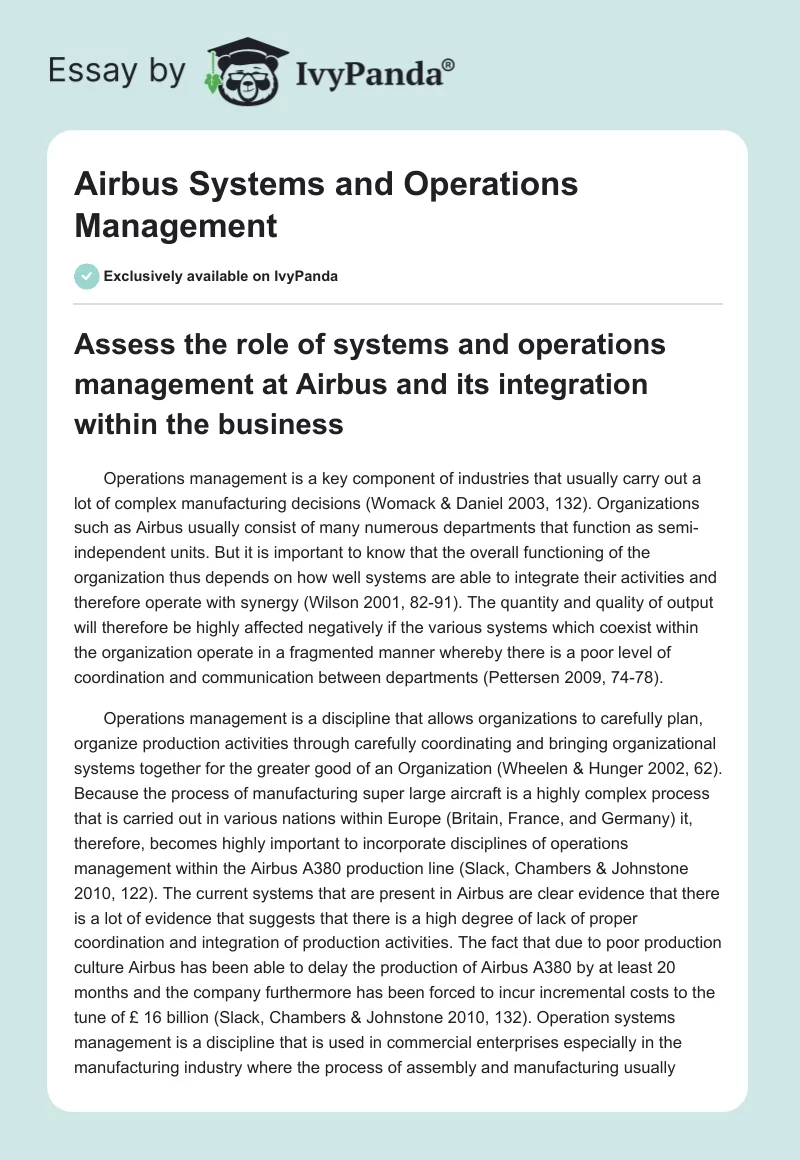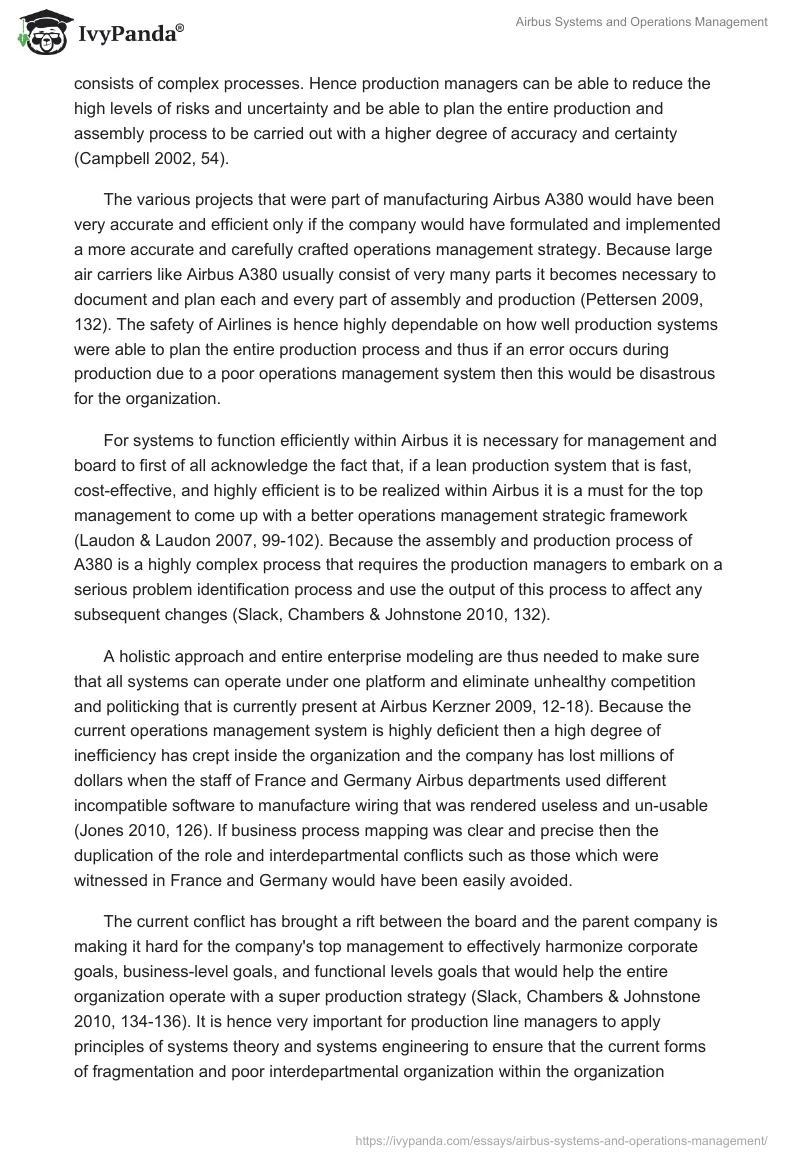Assess the role of systems and operations management at Airbus and its integration within the business
Operations management is a key component of industries that usually carry out a lot of complex manufacturing decisions (Womack & Daniel 2003, 132). Organizations such as Airbus usually consist of many numerous departments that function as semi-independent units. But it is important to know that the overall functioning of the organization thus depends on how well systems are able to integrate their activities and therefore operate with synergy (Wilson 2001, 82-91). The quantity and quality of output will therefore be highly affected negatively if the various systems which coexist within the organization operate in a fragmented manner whereby there is a poor level of coordination and communication between departments (Pettersen 2009, 74-78).
Operations management is a discipline that allows organizations to carefully plan, organize production activities through carefully coordinating and bringing organizational systems together for the greater good of an Organization (Wheelen & Hunger 2002, 62). Because the process of manufacturing super large aircraft is a highly complex process that is carried out in various nations within Europe (Britain, France, and Germany) it, therefore, becomes highly important to incorporate disciplines of operations management within the Airbus A380 production line (Slack, Chambers & Johnstone 2010, 122). The current systems that are present in Airbus are clear evidence that there is a lot of evidence that suggests that there is a high degree of lack of proper coordination and integration of production activities. The fact that due to poor production culture Airbus has been able to delay the production of Airbus A380 by at least 20 months and the company furthermore has been forced to incur incremental costs to the tune of £ 16 billion (Slack, Chambers & Johnstone 2010, 132). Operation systems management is a discipline that is used in commercial enterprises especially in the manufacturing industry where the process of assembly and manufacturing usually consists of complex processes. Hence production managers can be able to reduce the high levels of risks and uncertainty and be able to plan the entire production and assembly process to be carried out with a higher degree of accuracy and certainty (Campbell 2002, 54).
The various projects that were part of manufacturing Airbus A380 would have been very accurate and efficient only if the company would have formulated and implemented a more accurate and carefully crafted operations management strategy. Because large air carriers like Airbus A380 usually consist of very many parts it becomes necessary to document and plan each and every part of assembly and production (Pettersen 2009, 132). The safety of Airlines is hence highly dependable on how well production systems were able to plan the entire production process and thus if an error occurs during production due to a poor operations management system then this would be disastrous for the organization.
For systems to function efficiently within Airbus it is necessary for management and board to first of all acknowledge the fact that, if a lean production system that is fast, cost-effective, and highly efficient is to be realized within Airbus it is a must for the top management to come up with a better operations management strategic framework (Laudon & Laudon 2007, 99-102). Because the assembly and production process of A380 is a highly complex process that requires the production managers to embark on a serious problem identification process and use the output of this process to affect any subsequent changes (Slack, Chambers & Johnstone 2010, 132).
A holistic approach and entire enterprise modeling are thus needed to make sure that all systems can operate under one platform and eliminate unhealthy competition and politicking that is currently present at Airbus Kerzner 2009, 12-18). Because the current operations management system is highly deficient then a high degree of inefficiency has crept inside the organization and the company has lost millions of dollars when the staff of France and Germany Airbus departments used different incompatible software to manufacture wiring that was rendered useless and un-usable (Jones 2010, 126). If business process mapping was clear and precise then the duplication of the role and interdepartmental conflicts such as those which were witnessed in France and Germany would have been easily avoided.
The current conflict has brought a rift between the board and the parent company is making it hard for the company’s top management to effectively harmonize corporate goals, business-level goals, and functional levels goals that would help the entire organization operate with a super production strategy (Slack, Chambers & Johnstone 2010, 134-136). It is hence very important for production line managers to apply principles of systems theory and systems engineering to ensure that the current forms of fragmentation and poor interdepartmental organization within the organization structure of Airbus are quickly resolved. Additionally by incorporating operation research practices then Airbus can create appropriate flow charts that will assist the organization to streamline its production practices (Kerzner 2009, 6-10).
Explain how the Airbus information systems and operations management should be updated to support and improve their business efficiency
The current operation management systems at Airbus exhibit a lot of problems and this has interfered with the production of A380 and led to delays in the completion of Airbus A380 thus hurting the corporate goals and ambitions of the company (Kourdi 2009, 205). Furthermore, the company has been forced to face extra costs that made the previously planned budget of £ 1.45 billion rises to approximately £ 16Billion all these incremental costs have been a result of poor operations and project management strategy within Airbus (Slack, Chambers, & Johnstone 2010 122-132). The current poor information management culture is making it hard for other elements of project and operations management strategy to end up paralyzed (Laudon & Laudon 2007, 154). The current communication inefficiencies have also led to a rift between the parent company EADS and the management at Airbus with the parent company accusing the board of suppressing the flow of information (Kerzner 2009, 128).
It is hence necessary for the company to put in place a highly effective operations strategy that is backed by a well structured need-based information system that the company will use to successfully meet production deadlines and also reduce costs by accurately delivering critical information to each and every division when the need arises (Laudon & Laudon 2007, 103-114). Consequently, it is thus appropriate to conclude that the current information management strategy is not good enough for the company and is therefore injuring the corporate mission and vision of the company. Besides the fact that many customers of Airbus have been angered by the 20-month delay that was witnessed in the production of A380, it is quite clear that various subsystems and departments of Airbus are in conflict thus making it very hard for the company to effectively achieve its production objectives (Slack, Chambers, & Johnstone 2010, 135). The current information system systems do not enable management to effectively map all business processes using data flow charts that clearly define production processes in hierarchical format within the organization (London & Loudon 2007, 35-44).
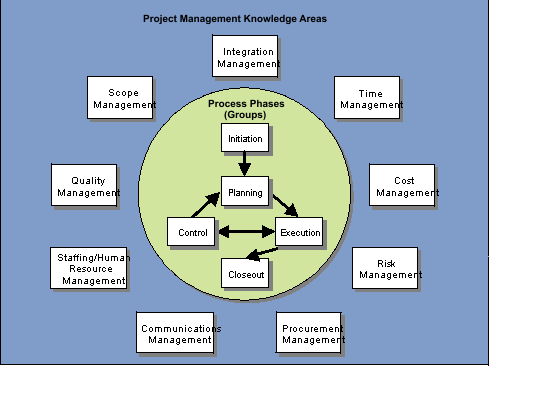
Once the entire assembly process is clearly mapped then human resource managers and departmental heads should go ahead and define the role of each and every employee in each and every division and organize training for them and disburse relevant information that these employees need to operate with high efficiency. This is because during the production of the Airbus A380 the French and German department took up to four months to conduct the simple task of wiring which usually takes less than 3 weeks simply because the two divisions did not cooperate and communicate with each appropriately thus leading to duplication of roles (Ronen & Pass 2007, 126). Furthermore, the French and German department’s poor coordination and communication culture led the two departments into using incompatible software by mistake to design 500km’s of wiring that led to cabling problems that delayed the production schedule of the Airbus A380. The cabin and fuselage cross-border division has made it clear that the current systems are not up to date and therefore production and assembly schedules end up overcrowded making it difficult to meet the intense production schedules (Mahadevan 2005, 128; Charles et al 2009, 127).
Thus, by mapping the entire business process, information critical to production within the organization should be managed by a centralized information management system. By centralizing information then the likely hood of duplication of roles will be reduced because only departmental heads will be in charge of retrieving data critical to production and communicating this to employees on the factory floor (Laudon & Laudon 2007, 88-102). Since Airbus consists of various systems which are either divisions or departments it would then be highly appropriate to use a soft systems approach to identify problems and concerns of the various stakeholders who exist within this system (Wilson 2001, 48). CATWOE is a term that is used together with the soft system method to critically analyze and define the actual publics/stakeholders that the problems within the systems affect and these stakeholders consist of Clients in this case the various airlines purchasing the Airbus A380, Actors individuals such as the media, Transformation who consist of employees who transform input into output, Worldview, owner and the Environmental (Petersen 2009, 56-72).
Once each and every need of the various systems will be identified then a more prioritized and objective solution process will be initiated. It thus necessary to acknowledge that each and every system within an organization has a diverse set of needs and in order for a good operations management strategy to be put in place, these needs must be identified accurately. If the information requirement of each and every department is properly catered for then the level of fragmentation within Airbus would reduce because the information will result in the empowerment of various division (Slack, Chambers, & Johnstone 2010, 134-136)It is thus important to note the company should strive to develop an information system that is need-based, by doing so the particular need for each and every department/division within Airbus will be catered for and improve all operations/project management concerns.
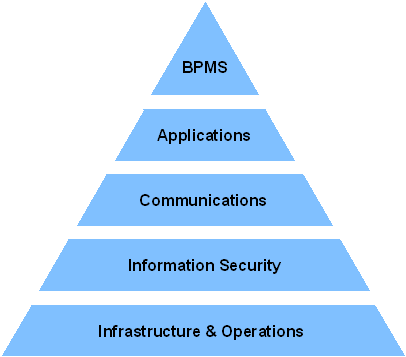
Evaluate the role of Soft Systems Methodology in analyzing and defining the business requirements of Airbus
The Current operations at Airbus are troubled and this can be witnessed through the elongated time frames and increased production costs (Slack, Chambers, & Johnstone 2010, 134-136). The top management and the board of Airbus have been unsuccessful in achieving the production targets of Airbus A380 and therefore this has also shocked other stakeholders. In order to change the current situation, a complete investigation should be carried out to understand the particular systems that exist within Airbus and come up with a mechanism that will enable the responsible parties to formulate the most appropriate mechanisms to enable the organization to operate at high levels of efficiency (Phillips 2003, 161). A soft systems methodology is a system that takes into consideration the exact needs of each and every stakeholder within the whole system (Tonchia & Cozzi 2008, 76-71). Since organizations can be considered as a system with various subsystems it is vital that the problem identification process takes into consideration the needs of each and every system. And as a result, if the need of each and every system is taken into consideration then this means that the proposed solutions that will arise out of this process will most likely be tailor-made and meant for each and every system (Phillips 2003, 116).
A soft System Methodology is a holistic approach that will allow Airbus to use a holistic approach to help Airbus solve various cultural, psychological, and social issues that may be injuring operation management targets within Airbus. For example, the political rivalry between the French and German divisions is unhealthy and thus unnecessary because being employees of the same organization should work together towards the same goal and thus not fight amongst each other (Slack, Chambers & Johnstone 2010, 126-128). The advantage of using a Soft Systems Methodology is that Airbus can therefore easily enter into a problem-solving situation by expressing the problem situation through understanding its symptoms that are witnessed within various sub-systems within Airbus for example the conflict that arose between the parent company EADS and the Board of Airbus. Secondly, the process of formulating root definitions of relevant systems will thus assist the organization to understand how each system works and how the output of each and every system can be easily manipulated to the benefit of Airbus (Slack, Chambers, & Johnstone 2010, 134-136). Additionally, once the root definitions of relevant systems are well-defined experts can then go ahead and construct Conceptual Models of Human Activity within the Systems, and finally comparing the models with the real world are often activities in day to day operations of Airbus (Wilson 2001, 74-77).
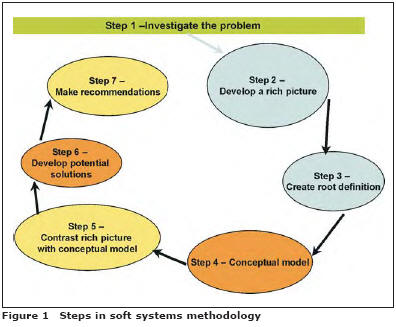
Currently, Airbus has a poor culture which is primarily witnessed through wastage of resources (time and money) within the organization. In order to alter the current organizational culture the Soft System Method can be used to identify the particular need of each and every department once the particular needs of this systems are identified by the current symptoms such as wastage of funds, wastage of time, politicking and poor coordination then initiate changes where necessary(Wilson 2001, 76). Furthermore, a Soft System Methodology will assist Airbus to streamline its processes and put in place industrial reengineering practices that will aim to improve on how operations management practices are being carried out within Airbus the current systems are deficient and have not assisted the organization in carefully planning the assembly of Airbus A380 (Wilson 2001, 115).
If the needs are accurately defined then all stakeholders can have their interests looked into for the benefits of Airbus. A good operations management system will hence allow Airbus to achieve its mission and vision by accurately mapping and planning sequential activities within the organization. It seems that currently Airbus is unable to prioritize what is important and thus with the use of SSM Airbus will successfully be able to identify the critical path of all production activity and thus save on time by working within a short time frame (Wilson 2001, 188). The use of operational research activities will thereof in advance statistically calculate, prioritize and estimate a more accurate total time frame that all production activities that are to take place within Airbus. In conclusion, the ability of the Soft System Methodology to bring together the interests of all stakeholders and carefully incorporate them in the need recognition and problem-solving process assists the performance of subsystems that exist within an organization more carefully plan their operation management and project management needs (Wilson 2001,77).
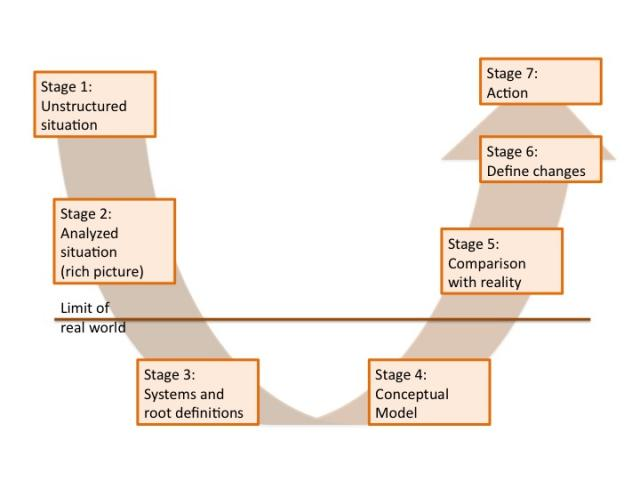
Analyze the people, technology, and organizational issues involved in improving the operations at Airbus
People Issues
It is very critical that organizations for which want to achieve production optimization operate with the appropriate technology, a good organizational structure, and also have a relationship of individuals within the organization (Deal & Kennedy, 2000 154). The current nature of relationships between the various divisions of Airbus cannot be described as good. The current disagreement between the parent company EADS and Airbus is a good example of a people issue that has, in turn, affected the efficient functioning of Airbus, EADS has blamed the board for withholding important information from stakeholders and have led to the resignation of the Board members (Slack, Chambers, & Johnstone 2010 126-130).
Furthermore, the nature of problems experienced in France and Germany is simply because of unhealthy competition and rivalry between the two divisions (Slack, Chambers, & Johnstone 2010, 134-136). As these divisions try to outshine each other they do so at the expense of Airbus. Simply because the two departments refused to collaborate and coordinate their activities and adopted a do it by yourself culture the overall output of these departments was compromised and the two departments went ahead and produced two different 500km Cables that resulted in wiring problems and further delays in the production of Airbus A380.The problem that resulted in the production of two 500km cables would have easily been avoided if the people culture of the employees in the two divisions was appropriate for the organization (Slack, Chambers, & Johnstone 2010 128).
Organization issues
The current organizational structure within Airbus is to some extent not functioning well to meet the performance requirements of the organization (Campbell, Stonehouse & Huston, 2002, 63). A good organizational structure allows an organization to structure the role of all employees within the organization in such a way that clarity of roles is easily achieved. The current organizational structure in Airbus is not suitable because the roles and tasks between the French and German department are no well defined and hence this is why employees of Airbus have ended politicking and fighting for control thus injuring the level of output (Slack, Chambers, & Johnstone 2010 126). If the current organizational structure system was appropriate then Airbus would have a clear route of Authority that would allow divisional heads to clearly assign roles and tasks between individuals (Roy 2005, 172).
Furthermore, it would be possible for the organization to set up a hierarchy that would define the power of workers therefore by having a clear structure of power employees would find it hard to politicize the production process (Campbell, Stonehouse & Huston, 2002 153). Mario Heinen, who is the head of the cabin and fuselage cross-border division, has severally complained that the current system in Airbus is very disorganized and this has made the process of scheduling production, much harder as a result of overcrowding (Slack, Chambers & Johnstone 2010, 133). It is thus necessary for organizational leaders to come together and use business mapping, and create process flow charts that will enable the organization to operate more efficiently and reduce the level of disorganization that currently exists in Airbus (Ireland 2006, 186).
Technology
Technology and automation are an important part of Airbus operations simply because the process of making Aircraft is highly complex and sometimes accuracy can be achieved if the technology is used (Hakes 2005, 104). Technology may often consist of information systems, software, and robot arms. In order for lean manufacturing and streamlining manufacturing to be successful the Airbus will be required to use the latest statistical techniques that will allow the manufacturing process to be highly precise by assembly robots to handle most of the assembly processes thus plummeting errors that may arise as a result of human misjudgment (Wang 2000, 36). The current software technology of Airbus is not up to date simply because of the existence of two different incompatible software versions that were supposed to make 500km of wiring (Slack, Chambers & Johnstone 2010, 126-130). If the technology was up to date then management would have got rid of the software that was considered incompatible. Furthermore, electricians admit that the current wiring systems are outdated and thus the electricians will be required to update the current computer blueprints in order to make the current production and assembly process more efficient (Slack, Chambers & Johnstone 2010, 128). Furthermore, the current information systems in Airbus this is because the current information management systems are not technologically up to date to respond to the various needs of the various divisions in Airbus.
References
Campbell, D., 2002. Business Strategy An Introduction. New York: A Butterworth-Heinemann.
Campbell, D., Stonehouse, G. & Huston, B., 2002. Business Strategy an Introduction, 2 and. Linacre House, Banbury Rd: Butterworth-Heinemann.
Charles, E. et al, 2009. Essentials of Marketing. Natorp Boulevard: Cengage Learning.
Deal, T. E. & Kennedy, A. A., 2000. Corporate Cultures: The Rites and Rituals of Corporate Life. Cambridge: Perseus Publishing.
Hakes, C,, 2005. Total quality management The Key to Business Improvement’s. Suffolk: Edmunds bury Press Ltd.
Ireland, L. R., 2006. Project Management. New York: McGraw-Hill Professional.
Jones, G., 2010. Organizational theory, design, and change. Upper Saddle River: Pearson.
Kerzner, H., 2009. Project Management: A Systems Approach to Planning, Scheduling, and Controlling, 10th ed. New Jersey: John Wiley and Sons.
Kourdi, J., 2009. Business Strategy: A Guide to Effective Decision Making, 2 edn. New York: Economist Books.
Laudon, J. P. & Laudon, K. C., 2007.Management Information Systems: Managing the Digital Firm. New York: Prentice-Hall.
Mahadevan R., 2005. Operations Management: Theory and Practice. New Delhi: Pearson Education India.
Pettersen, J., 2009. “Defining lean production: some conceptual and practical issues.” The TQM Journal, 21(2), 127 – 142.
Phillips, J., 2003. PMP Project Management Professional Study Guide. New York: McGraw-Hill.
Ronen, E. & Pass, S., 2007. Focused operations management: achieving more with existing resources. New Jersey: John Wiley and Sons.
Roy, R.M., 2005. Operations Management: Theory and Practice. New York: New Age International.
Slack, N., Chambers, S. & Johnstone, R., 2010. Operations Management, 6th Ed. Harlow: Pearson.
Torchia, S, & Cozzi, F., 2008. Industrial Project Management: Planning, Design, and Construction. New York: Springer.
Wang, J. X., 2000. What Every Engineer Should Know About Risk Engineering and Management. New York, NY: Marcel Dekker.
Wheelen, T. L. & Hunger J. D., 2002. Strategic Management and Business Policy. New Jersey: Prentice-Hall.
Wilson, B., 2001. Soft Systems Method: Conceptual model building and its contribution. Chichester: John Wiley and sons.
Womack, J. P. & Daniel, T. J., 2003. Lean Thinking. New York: Free Press.

